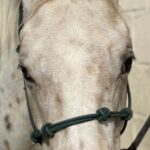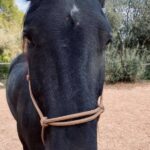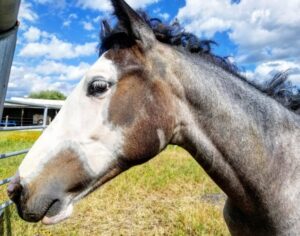The slightest change in the location of a horse’s whorls can make huge differences in temperament.
No where is that more difficult to figure out than in side by side and diagonal double whorls. These whorls show almost exact opposites in temperament types among horses. The whorls themselves can be almost impossible to tell apart!
High side by side doubles can be two very clear whorls, in a straight horizontal line, touching or very close to each other. Or, one whorl can be barely visible, there can be lots of feathering, or not, or, most difficult of all, they can be set at a slight angle. When the side by side whorls are at a slight angle they have to be perfectly clear. The whorls can’t be faint and they do have to be very close together. These horses are extroverts, bold, brave, sensitive, will let you know exactly what they are thinking.
Diagonal double whorls are always set at an angle to each other, they can be set at a small distance apart. In fact that is one way to tell the difference. Diagonal double whorls are usually an inch or so apart and one of them is usually very faint and hard to see, a ghost whorl. Feathering will arch over, or under, the two whorls connecting them. When a diagonal double whorl looks like this they are easy to recognize. These horses are introverts, hesitant, need time to think things through, will draw into themselves and not show a reaction until they explode if you keep pushing and miss the subtle signs they’re upset.
The difficulty comes when the diagonal double is clear, easy to see, set close together, and only at a slight angle.
How do we tell this apart from a side by side double at a slight angle?
I don’t have a good answer. One possible way would be ears and head shape. Introverts tend to carry their ears back. Not laid back and mad, just facing backwards. Side by side whorls tend to have moose noses, bold features, convex, and sensitive. Right brain introverts tend to have very sensitive features and can also have convex profiles, making the difference even harder to tell.
So where do we draw the line? How do we tell for sure which diagonal double whorl will be introverts and which extrovert? I’m afraid I don’t know the answer to that. Here’s to more learning and getting this figured out!
These two horses are not going to help solve this puzzle. One is a diagonal double the other side by side, according to their owners descriptions of temperament. Can you guess which is which? If we look closely there is a small difference in the whorl placement that seems to be our only clue.
-

-
This one is a ide by side double
-

-
This one is the diagonal double. There is a bit more of an angle to the whorls


